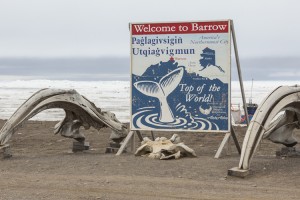Introducing Utqiagvik, Alaska
December 21, 2016
Barrow, Alaska, the northernmost community in the United States, will soon be renamed Utqiagvik (UHT kah giv ihk), Alaska, following a recent municipal election where voters narrowly approved the name change ordinance. The change returns the name of the town to its original Iñupiat name. The Iñupiat, an indigenous (native) North Alaska Inuit people, make up the majority of the town’s 4,300 people. Barrow lies about 320 miles (515 kilometers) north of the Arctic Circle on the Chukchi Sea in the Arctic Ocean. Barrow is just south of Point Barrow, Alaska’s northernmost point, on the state’s North Slope.

Whale bones and a sign welcome people to Barrow, Alaska, soon to be renamed Utqiagvik. It is the northernmost community in the United States. Credit: © Michelle Holihan, Shutterstock
The name change was celebrated by local Iñupiat, who worry that their native language and traditional culture might soon be lost. Scholars at the Alaska Native Language Center at the University of Alaska in Fairbanks estimate that only about 3,000 Iñupiat still speak their native language. Iñupiat is related to other Inuit languages spoken in the vast circumpolar region stretching from Alaska across Canada to Greenland.
People have lived in remote Utqiagvik for over 1,000 years. Archaeologists have found evidence of human activity in the area as early as A.D. 500. Native Iñupiat people called the location Utqiagvik (high place for viewing) because of a high bluff overlooking the sea. The name may also refer to a location where wild roots could be collected for food in the summer. A British mapping expedition visited the area in 1826. The expedition members named nearby Point Barrow for Sir John Barrow, the second secretary of the British Admiralty and a sponsor of the expedition. The village was known primarily by various Iñupiat names until 1901, when the U.S. Post Office Department made the name Barrow official.
In the municipal elections held on October 10, 2016, Barrow residents voted to restore its indigenous name. Fittingly, the election was held on Columbus Day, a federal holiday that honors the first voyage of Christopher Columbus to America in 1492. It is not an official state holiday in Alaska, where Governor Bill Walker signed a proclamation declaring the date shall also be recognized as Indigenous Peoples Day. In the proclamation, Walker noted that more than 16 percent of Alaska’s population is indigenous, the highest percentage of any U.S. state. Barrow’s name change is not a 100-percent done deal, however. City officials must first coordinate with Alaska state offices to make the necessary changes on government documents, maps, signs, and websites. There are also legal challenges to the name change in Alaska courts. A year ago in 2015, Alaska’s Mount McKinley, the highest peak in North America, reverted to its indigenous Athabascan name, Denali.


